 |
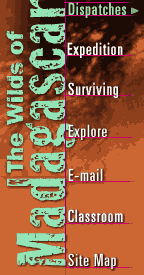 
56k | ISDN Get RealPlayer software |
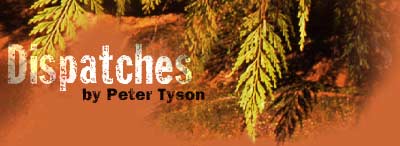 June 4, 2000 A Great Day for Silkies
The day began before dawn, when Loret Rasabo and Malagasy graduate student Felix Ratelolahy headed out of camp to find the sleeping trees of the troop of silky sifaka we've been following for several days. By about 7:30, Rasabo had anesthetized four animals and begun the long trek back to camp to work them up in our makeshift lab and then release them. But he never made it to the lab. Around 9:30, Pat Wright came huffing up the trail to the lab, which lies just down the hill from my tent. "We've got four animals," she said, out of breath. "It's too slippery to bring them down, so we're going to process them in the forest." She didn't need to say "You coming?" I had my gear on my back inside a minute, just in time to follow Wright and a few others back down the trail with the necessary lab equipment. We crossed the stream and headed up along a trail slick from rain. Long brushstrokes in the mud showed where others had slipped before us. Placing our feet only on roots and rocks, we soon reached a narrow ridge where the team had assembled in an airy glade of thin-boled trees. There on burlap sacks lay four silky sifaka, three males and one female. They were sleeping quietly, with broad green leaves laid over their faces to keep the sun out of their still open eyes. I could see their white-furred chests gently breathing in and out. Silkies are the quintessence of lithe and lanky, all arms and legs and long white tails. They had heads round and big as softballs, with black and pink skin on their faces and large, brown eyes with black pupils resembling our own. Their ears were all but lost in the thick fur, which was soft as cashmere and smelled remarkably clean, "like a stuffed toy straight out of F.A.O. Schwartz," as Wright remarked.
When I arrived on the scene, the team was already at work getting the first measurements ever taken of a silky sifaka. The smell of alcohol hung in the air. The only sounds were the low voices of the team at work and the occasional dog-like bark out in the forest of what our guides assure us is a barking crab. Wright immediately asked whoever took a measurement to relay the figure to the one recording the data and, when the recorder repeated the measurement, to respond "okay." "It is so important," she said, "because if we get the wrong number, it's the wrong number for this species." While Mayor recorded, Rasabo and Ratelolahy laid a measuring tape along key body parts. They measured the lemurs' sharp teeth with calipers, weighed each animal with a hand-held scale, and took blood, skin, and hair samples. Safia Salimo, another Malagasy graduate student, and Desiré Rabary picked parasites out of the sifaka's fur and placed them in vials full of alcohol. The blood will help decide this animal's relatedness to the other four sifaka species on the island. It will also aid in determining whether any genetic deterioration has taken place in what is presumed to be a small population here at Marojejy. Researchers can also use DNA in the follicles of the hair to investigate the species' genetics, while a study of isotopes in the hair can reveal differences in diet and habitat between this and other diademed sifaka. While Mayor and Rasabo did most of the work on the animals, Wright kept a close eye on things, helping with blood samples and occasionally offering advice. Most everyone on that hillside, whether Western or Malagasy, was her student.
When most of the work was done, I was one of several fortunate people given a sifaka to hold as it slowly came out of the anesthetic. I had a male perhaps 10 or 12 years old. He was the old man of the group, with a wrinkled pink face and droopy eyes. Because of his age, he recovered more slowly from the anesthetic than his younger relatives and mostly just sat there unmoving in my arms. I could feel his heartbeat pulsing beneath the thin fur of his chest. Now and then he swung his round head around to gaze quizzically at me with his watery eyes, and once when shifting he suddenly ringed my wrist in a tight grip, the fleshy pads of his long fingers cool to the touch. Later, one of the younger sifaka began grunting in what Wright said was the "moving" call. "It's a good sign," she said, "because it's what they use when they want to be on the move." By now it was mid-afternoon, and the sifaka would be fully awake within an hour or two and ready for release. To keep them calm until they were fully restored to consciousness, Rasabo placed them delicately into the gunnysacks. After a late lunch of rice and vegetables, we returned to the ridge under a darkening sky. As we all gathered around, Rasabo carefully opened the sack containing my elderly friend and offered him a sapling with which to climb to freedom. The old lemur came out slowly and moved off only a short way to rest and watch us with those watery eyes. Rasabo then let the others go. Unlike their elder, when they saw the offered tree trunk, they eagerly wrapped fingers and opposable thumb around it and dashed up eight or ten feet in the blink of an eye. There they paused to look back at us as if to say, "Are you really letting us go?"
"Tomorrow, June 5th, is the National Day of the Environment in Madagascar," Wright said earlier as she cradled one of the slowly awakening silkies in her lap. "It's a big celebration. The Prime Minister will be there, and many other important Malagasy officials. We're so happy at this auspicious moment to be helping to conserve these beautiful animals in the new Marojejy National Park." Mayor, for her part, appreciated the culmination of a project long in the planning. "We've been waiting for this moment for months," she said. When Wright laughingly suggested years, Mayor said, "Right, years, years." The most unexpected reaction to our success today came from Desiré Rabary. As night fell and I had just begun to write this dispatch, Rabary appeared at my tent in the usual polite way Malagasy have of approaching slowly, as if ready to retreat at a moment's notice. He stuck his jovial face through the opening and said, "You have done a very great thing." It took me a moment to realize he meant the team as a whole. "I want to thank you. You have shown us guides something we would never see, and we can tell other visitors about it. It was very special." All in all, not a bad first day in the life of Marojejy National Park, wouldn't you say? Peter Tyson is Online Producer of NOVA. Dispatches Forest of Hope (June 7, 2000) A Great Day for Silkies (June 4, 2000) Camp Life Unveiled (June 3, 2000) Three Hours with the Silkies (June 1, 2000) Angels of Marojejy (May 31, 2000) Wildlife (May 30, 2000) Into the Marojejy Massif (May 28, 2000) Croc Cave (May 26, 2000) Fossa! (May 25, 2000) Bat Cave (May 24, 2000) Update: English Camp (May 23, 2000) Update: Sunken Forest (May 21, 2000) Update: Night Walk (May 20, 2000) Update: 70 Feet Up (May 19, 2000) Update: Tropical Downpour (May 18, 2000) Photos: Peter Tyson. The Expedition | Surviving The Wilds | Explore Madagascar Dispatches | Classroom Resources | E-Mail | Resources Site Map | The Wilds of Madagascar Home Editor's Picks | Previous Sites | Join Us/E-mail | TV/Web Schedule About NOVA | Teachers | Site Map | Shop | Jobs | Search | To print PBS Online | NOVA Online | WGBH © | Updated November 2000 |
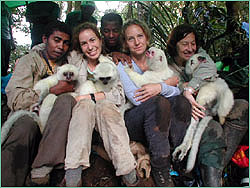 With Malagasy graduate student Felix Ratelolahy looking on, Loret Rasabo,
Mireya Mayor, Jacinth O'Donnell, and Pat Wright embrace still awakening silky
sifaka before setting them free in their home range.
With Malagasy graduate student Felix Ratelolahy looking on, Loret Rasabo,
Mireya Mayor, Jacinth O'Donnell, and Pat Wright embrace still awakening silky
sifaka before setting them free in their home range.
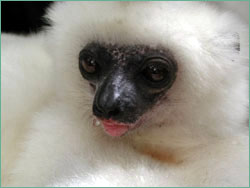 Though they were asleep, the silky sifaka had their eyes open and drank water
freely from a syringe. Here, a drop of water still clings to the furry chin
of a silky.
Though they were asleep, the silky sifaka had their eyes open and drank water
freely from a syringe. Here, a drop of water still clings to the furry chin
of a silky.
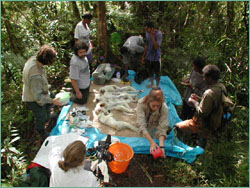 On the trail high above Camp Two, the team takes the first measurements ever
taken of the silky sifaka.
On the trail high above Camp Two, the team takes the first measurements ever
taken of the silky sifaka.
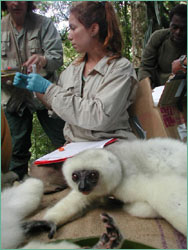 With Wright looking on, Mireya Mayor records a blood sample taken from one of
the silky sifaka, one of which begins to awaken.
With Wright looking on, Mireya Mayor records a blood sample taken from one of
the silky sifaka, one of which begins to awaken.